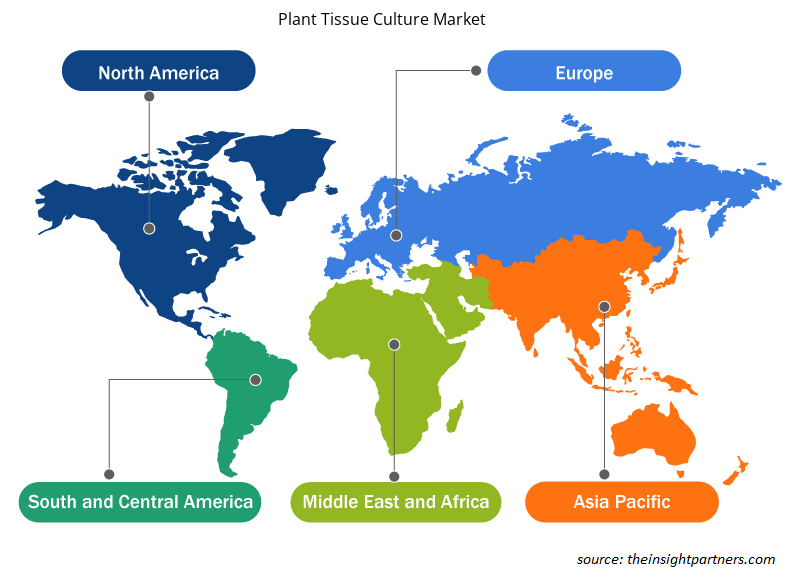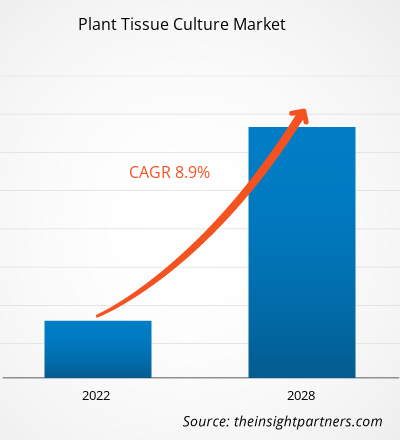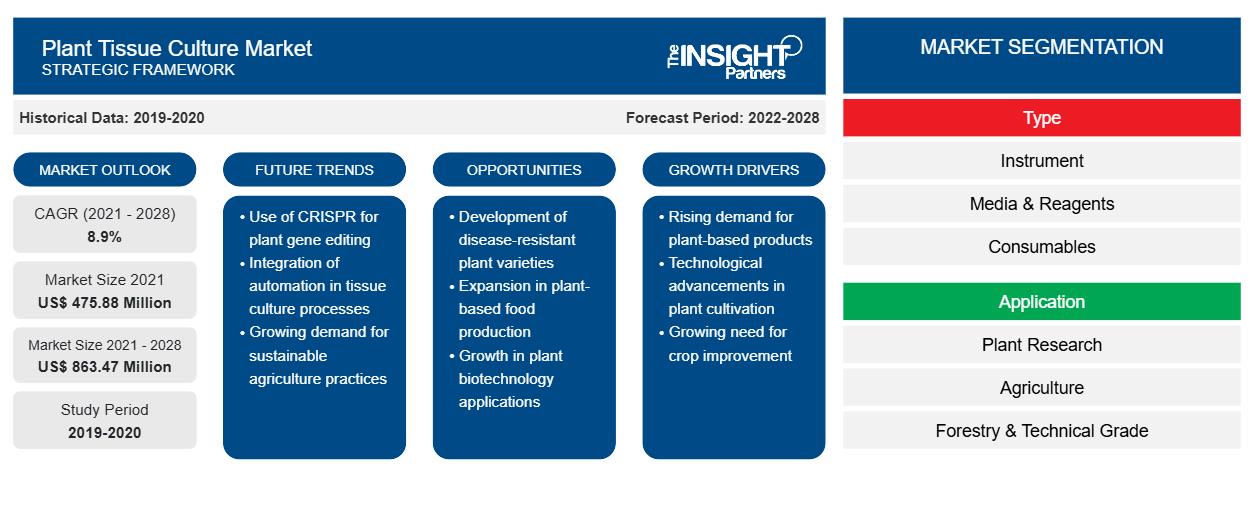[تقرير بحثي] بلغت قيمة سوق زراعة الأنسجة النباتية 475.88 مليون دولار أمريكي في عام 2021، ومن المتوقع أن تنمو بمعدل نمو سنوي مركب نسبته 8.9٪ من عام 2022 إلى عام 2028.
زراعة الأنسجة النباتية هي مجموعة من التقنيات المستخدمة لزراعة الخلايا أو الأنسجة أو الأعضاء النباتية في ظل ظروف المختبر على وسط زراعة معروف التركيب. يمكن إنتاج استنساخات من النباتات من خلال التكاثر الدقيق. تمكن زراعة الأنسجة من إنتاج مواد زراعة عالية الجودة وخالية من الأمراض. كما أنها تسهل النمو السريع والموحد للنباتات. الطلب المتزايد على النباتات المعدلة وراثيًا وانتشار زراعة الزهور هي العوامل الرئيسية التي تدفع نمو السوق. ومع ذلك، فإن التكلفة العالية لإجراءات زراعة الأنسجة تعيق تقدم السوق.
يتم تحليل سوق زراعة الأنسجة النباتية على أساس التكنولوجيا والتطبيق والمواد والجغرافيا. يقدم التقرير رؤى وتحليلات متعمقة لسوق زراعة الأنسجة النباتية، مع التركيز على معايير مختلفة مثل اتجاهات السوق والتقدم التكنولوجي وديناميكيات السوق، وتحليل المنافسة بين اللاعبين الرئيسيين في السوق.
قم بتخصيص هذا التقرير ليناسب متطلباتك
ستحصل على تخصيص لأي تقرير - مجانًا - بما في ذلك أجزاء من هذا التقرير، أو تحليل على مستوى الدولة، وحزمة بيانات Excel، بالإضافة إلى الاستفادة من العروض والخصومات الرائعة للشركات الناشئة والجامعات
-
احصل على أهم اتجاهات السوق الرئيسية لهذا التقرير.ستتضمن هذه العينة المجانية تحليلاً للبيانات، بدءًا من اتجاهات السوق وحتى التقديرات والتوقعات.
رؤى السوق
الطلب المتزايد على النباتات المعدلة وراثيًا يعزز نمو سوق زراعة الأنسجة النباتية
النباتات المعدلة وراثيًا هي تلك النباتات التي يتم تعديل حمضها النووي باستخدام تقنيات الهندسة الوراثية لإدخال سمة جديدة إلى النبات لا تحدث بشكل طبيعي. يتم إنتاج هذه النباتات المعدلة وراثيًا باستخدام تقنيات الهندسة الوراثية في المختبر عن طريق تغيير التركيبة الجينية، وعادةً عن طريق إضافة جين واحد أو أكثر إلى جينوم النبات. يتم تطوير النباتات المعدلة وراثيًا بشكل أساسي لتوفير العناصر الغذائية الضرورية والتعامل مع الطلب على الغذاء في جميع أنحاء العالم.
يعاني ملايين البشر من سوء التغذية، وهو أكثر انتشارًا في البلدان النامية والمتخلفة. ووفقًا لمنظمة الصحة العالمية، في عام 2019، كان حوالي 462 مليون شخص يعانون من نقص الوزن. ووفقًا لليونيسف، فإن ما يقرب من نصف جميع الوفيات بين الأطفال دون سن الخامسة تُعزى إلى نقص التغذية. وعلاوة على ذلك، في عام 2020، كان حوالي 45.4 مليون طفل دون سن الخامسة يعانون من الهزال، وحوالي 13.6 مليون منهم يعانون من الهزال الشديد. ووفقًا لمختبر بيانات التغيير العالمي، في عام 2019، كان 8.9٪ من سكان العالم يعانون من سوء التغذية. الأشخاص الذين يعانون من سوء التغذية هم أولئك الذين لديهم استهلاك السعرات الحرارية أقل من الحد الأدنى لمتطلبات الطاقة. يركز الباحثون على تطوير نباتات معدلة وراثيًا توفر السعرات الحرارية المطلوبة لتلبية متطلبات السعرات الحرارية هذه. إن الطلب على النباتات المعدلة وراثيًا يغذي نمو سوق زراعة الأنسجة النباتية.
رؤى مبنية على النوع
بناءً على النوع، ينقسم سوق زراعة الأنسجة النباتية إلى أدوات ووسائط وكواشف ومواد استهلاكية. احتل قطاع الأدوات أكبر حصة في السوق في عام 2021. ومع ذلك، من المتوقع أن يسجل قطاع المواد الاستهلاكية أعلى معدل نمو سنوي مركب خلال فترة التوقعات. تشمل الأدوات المستخدمة في زراعة الأنسجة النباتية الثلاجات ومحطات التقطير وأنظمة تدفق الهواء الرقائقي وميزان الوزن والحاضنات وأجهزة الطرد المركزي والمعقمات وما إلى ذلك.
رؤى قائمة على التطبيق
بناءً على التطبيق، يتم تقسيم سوق زراعة الأنسجة النباتية إلى أبحاث النباتات والزراعة والغابات والدرجة الفنية وغيرها. استحوذ قطاع الزراعة على أكبر حصة من السوق في عام 2021. ومع ذلك، من المتوقع أن يسجل قطاع أبحاث النباتات أعلى معدل نمو سنوي مركب خلال الفترة 2022-2028.
رؤى تعتمد على المستخدم النهائي
بناءً على المستخدم النهائي، يتم تقسيم سوق زراعة الأنسجة النباتية إلى دفيئات وحقول ومختبرات. احتل قطاع الحقل الحصة الأكبر من السوق في عام 2021. علاوة على ذلك، من المتوقع أن ينمو سوق هذا القطاع بمعدل نمو سنوي مركب قدره 9.2٪ خلال الفترة 2022-2028.
في العديد من البلدان، حد كوفيد-19 من تنقل الأشخاص عبر الحدود وساهمت عمليات الإغلاق في نقص العمالة في القطاعات الزراعية، وخاصة تلك التي تتميز بفترات ذروة الطلب الموسمي على العمالة أو الإنتاج كثيف العمالة. على سبيل المثال، أدى حظر السفر داخل الاتحاد الأوروبي، فضلاً عن إغلاق منطقة شنغن، إلى تقليص القوى العاملة المتاحة لقطاع الفاكهة والخضروات بشكل كبير في العديد من البلدان الأوروبية. وقد أدى نقص العمالة إلى خسائر في الإنتاج ونقص في السوق. وقد أضرت حالة الطوارئ الناجمة عن كوفيد-19 بالخدمات اللوجستية والتوزيع وسلاسل التوريد للمنتجات البستانية. وقد أدى هذا إلى انعدام الأمن الغذائي، بسبب انقطاع سلسلة توريد المنتجات الزراعية، وبالتالي، واجه جزء كبير من السكان صعوبة في الوصول إلى الغذاء الطازج بأسعار معقولة. وكان لهذه العوامل المذكورة أعلاه تأثير خطير على صناعة زراعة الأنسجة النباتية بشكل عام.
رؤى إقليمية حول سوق زراعة الأنسجة النباتية
لقد قام المحللون في Insight Partners بشرح الاتجاهات والعوامل الإقليمية المؤثرة على سوق زراعة الأنسجة النباتية طوال فترة التوقعات بشكل شامل. يناقش هذا القسم أيضًا قطاعات سوق زراعة الأنسجة النباتية والجغرافيا في جميع أنحاء أمريكا الشمالية وأوروبا ومنطقة آسيا والمحيط الهادئ والشرق الأوسط وأفريقيا وأمريكا الجنوبية والوسطى.

- احصل على البيانات الإقليمية المحددة لسوق زراعة الأنسجة النباتية
نطاق تقرير سوق زراعة الأنسجة النباتية
| سمة التقرير | تفاصيل |
|---|---|
| حجم السوق في عام 2021 | 475.88 مليون دولار أمريكي |
| حجم السوق بحلول عام 2028 | 863.47 مليون دولار أمريكي |
| معدل النمو السنوي المركب العالمي (2021 - 2028) | 8.9% |
| البيانات التاريخية | 2019-2020 |
| فترة التنبؤ | 2022-2028 |
| القطاعات المغطاة |
حسب النوع
|
| المناطق والدول المغطاة |
أمريكا الشمالية
|
| قادة السوق وملفات تعريف الشركات الرئيسية |
|
كثافة اللاعبين في سوق زراعة الأنسجة النباتية: فهم تأثيرها على ديناميكيات الأعمال
يشهد سوق زراعة الأنسجة النباتية نموًا سريعًا، مدفوعًا بالطلب المتزايد من المستخدم النهائي بسبب عوامل مثل تفضيلات المستهلك المتطورة والتقدم التكنولوجي والوعي المتزايد بفوائد المنتج. ومع ارتفاع الطلب، تعمل الشركات على توسيع عروضها والابتكار لتلبية احتياجات المستهلكين والاستفادة من الاتجاهات الناشئة، مما يؤدي إلى زيادة نمو السوق.
تشير كثافة اللاعبين في السوق إلى توزيع الشركات أو المؤسسات العاملة في سوق أو صناعة معينة. وهي تشير إلى عدد المنافسين (اللاعبين في السوق) الموجودين في مساحة سوق معينة نسبة إلى حجمها أو قيمتها السوقية الإجمالية.
الشركات الرئيسية العاملة في سوق زراعة الأنسجة النباتية هي:
- شركة سيجرا الدولية
- مشاتل جيه ار تي
- توماس ساينتيفيك ذ.م.م
- شركة سيجما-الدرتش المحدودة
- مختبرات هاي ميديا المحدودة
إخلاء المسؤولية : الشركات المذكورة أعلاه ليست مرتبة بأي ترتيب معين.

- احصل على نظرة عامة على أهم اللاعبين الرئيسيين في سوق زراعة الأنسجة النباتية
في عام 2022، استحوذت أمريكا الشمالية على أكبر حصة من سوق زراعة الأنسجة النباتية. ويعزى نمو السوق في هذه المنطقة إلى زيادة أنشطة البحث والتطوير في مجال زراعة الأنسجة. علاوة على ذلك، من المتوقع أن تسجل منطقة آسيا والمحيط الهادئ أسرع معدل نمو سنوي مركب خلال فترة التوقعات. تعد الصين واليابان والهند من المساهمين الرئيسيين في سوق زراعة الأنسجة النباتية في هذه المنطقة. ويعزى نمو السوق في منطقة آسيا والمحيط الهادئ إلى زيادة الاستثمارات الحكومية في تعزيز البحوث القائمة على زراعة الأنسجة، وارتفاع نطاقات تبني التقنيات المتقدمة، وتحسين البنية التحتية التي تدعم مختبرات زراعة الأنسجة.
من حيث الجغرافيا، يتم تقسيم سوق زراعة الأنسجة النباتية إلى أمريكا الشمالية (الولايات المتحدة وكندا والمكسيك)، وأوروبا (المملكة المتحدة وألمانيا وفرنسا وإيطاليا وإسبانيا وبقية أوروبا)، وآسيا والمحيط الهادئ (الصين واليابان والهند وكوريا الجنوبية وأستراليا وبقية آسيا والمحيط الهادئ)، والشرق الأوسط وأفريقيا (الإمارات العربية المتحدة والمملكة العربية السعودية وأفريقيا وبقية الشرق الأوسط وأفريقيا)، وأمريكا الجنوبية والوسطى (البرازيل والأرجنتين وبقية أمريكا الجنوبية والوسطى).
نبذة عن الشركة
- شركة سيجرا الدولية
- مشاتل جيه ار تي
- توماس ساينتيفيك ذ.م.م
- شركة سيجما-الدرتش المحدودة
- مختبرات هاي ميديا المحدودة
- شركة كايسون لابز
- مختبرات ألفا المحدودة
- بيكتون ديكنسون وشركاه
- مختبر الراجحي لزراعة الأنسجة
- الوثبة ماريونيت ذ.م.م
- التحليل التاريخي (سنتان)، سنة الأساس، التوقعات (7 سنوات) مع معدل النمو السنوي المركب
- تحليل PEST و SWOT
- حجم السوق والقيمة / الحجم - عالمي، إقليمي، بلد
- الصناعة والمنافسة
- مجموعة بيانات إكسل
التقارير الحديثة
شهادات العملاء
سبب الشراء
- اتخاذ قرارات مدروسة
- فهم ديناميكيات السوق
- تحليل المنافسة
- رؤى العملاء
- توقعات السوق
- تخفيف المخاطر
- التخطيط الاستراتيجي
- مبررات الاستثمار
- تحديد الأسواق الناشئة
- تحسين استراتيجيات التسويق
- تعزيز الكفاءة التشغيلية
- مواكبة التوجهات التنظيمية























 احصل على عينة مجانية ل - سوق زراعة الأنسجة النباتية
احصل على عينة مجانية ل - سوق زراعة الأنسجة النباتية